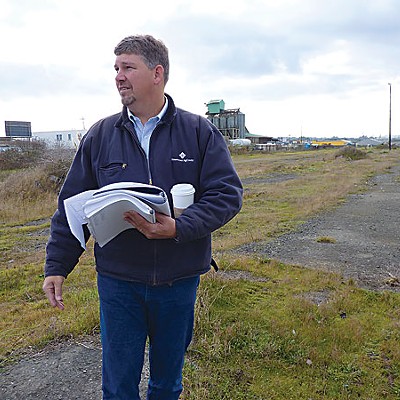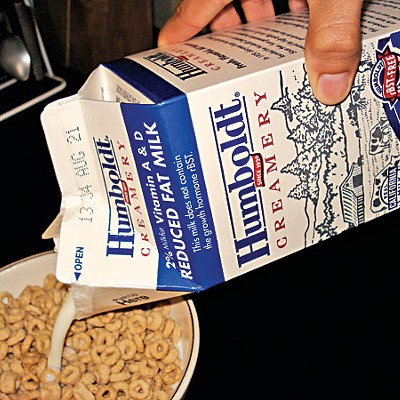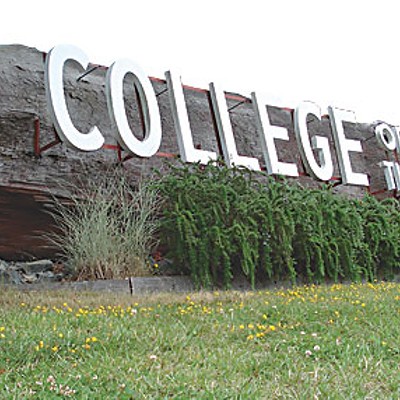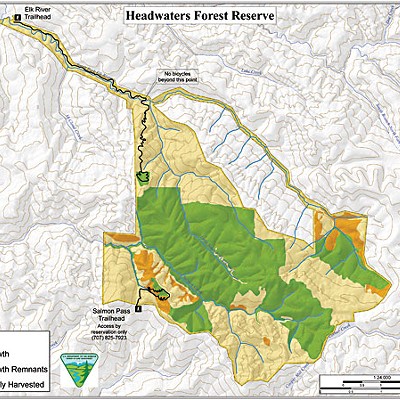1. Klamath Settlement
About a decade ago, it would be impossible to imagine the agreement that was announced in October. In 2001, you had farmers in the Klamath Basin going rogue, tearing away at the locks that held water from their crops. You had Dick Cheney taking a personal interest in their plight, reaching into his bureaucratic bag of tricks to curry the farmers' favor. And as a consequence, you had blacklisted fisheries scientists, their reports reversed, and up to 70,000 adult salmon dead on the banks the following year. The fishermen, the farmers, the tribes, the environmentalists -- all up and down the Klamath River, the largest and sickest in the region, there was plenty of hate and recrimination to spare.
Then something miraculous happened. Everyone sat down together, and, for years and years, attempted to work things out on their own. Even the energy giant PacifiCorps, owners of four dirty hydropower dams downstream of the farmers, was eventually brought into the fold. And this year, the groups that held out announced the final bit of a compromise solution that would result in the removal of the hydropower dams, a more equitable and sane system for the distribution of water resources, conservation assistance for the farmers, and a million other matters pertaining to the health and wellbeing of this extremely complicated ecosystem. The parties developed a framework over that time -- the settlement agreement -- and now they'll be working to make it happen.
But not everyone made it to the finish line. Did downstream interests compromise too much? The Hoopa Valley Tribe and some enviro groups think so. A rejectionist coalition called "Klamath Conservation Partners,"which is centered locally around the Northcoast Environmental Center, charges, among other things, that the agreement's extended timeline for dam removal is too long. The conservation partners have drafted alternative legislation that, if passed, would mandate that the dams would start to come down in 2012. How politically viable is this? Without support from upstream farmers and PacifiCorps ... not very.
The Humboldt County Board of Supervisors will hold a hearing on the subject next month, right before it takes the all-but-inevitable step of signing on in support the settlement. From there, the battle transfers to the states of California and Oregon and the federal government, all of which will have to pass legislation to get the ball rolling. California's voters will be obliged to weigh in next year, too -- California's share of dam removal costs are written into Gov. Schwarzenegger's omnibus water bond measure, which the legislature has placed on the ballot. Tying up Klamath restoration with politically charged issues like the Peripheral Canal is obviously less than ideal -- but as with all matters Klamath, there's the perfect solution and the possible solution.
-- Hank Sims
2. Creamgate
The bizarre saga of The Fall of Humboldt Creamery was easily the least expected, most confusing collapse of a local business in years. It began in February with word from Len Mayer, who had just stepped in as the company's interim CEO. He said longtime CEO Rich Ghilarducci had up and vanished while away on a business trip. "We can't get hold of him, we can't contact him, and he says [by lawyer-delivered letter] there's something wrong with the finances," Mayer said.
Indeed there was. Forensic accountants swooped in, capes flapping, to dissect the books of the 80-year-old Fernbridge institution. Their findings suggested that Ghilarducci had been deceiving current and potential investors, not to mention employees, board members and the 40-odd dairy farmers who owned 75 percent of the business, by fudging financial statements -- overstating assets and understating debts by millions and millions of dollars. Ghilarducci's lawyer denied it. But in April the company was forced to file Chapter 11 bankruptcy, and in an August court hearing, Modesto-based Foster Farms Dairy acquired Humboldt Creamery with a winning -- and solitary -- bid of $19.25 million.
The FBI launched a fraud investigation, and last month a criminal grand jury convened in San Francisco to consider indicting Ghilarducci. But the fallout hasn't been confined to the former CEO. Earlier this month, state officials sued local dairy farmers and their erstwhile cooperative for more than $400,000. The farmers contend that the state miscalculated, using Ghilarducci's goofy numbers. Regardless, local dairy suppliers and the surrounding community won't soon recover from the revelation that one of Humboldt County's greatest success stories was fictional.
-- Ryan Burns
3. Pot City, U.S.A.
The joint blew up this year! Much to the chagrin of county officials, anti-drugsters and, ironically, rapacious, chest-puffing ganja growers themselves, Humboldt County (and Arcata in particular) became a nationwide media cautionary tale -- a case study in the unintended consequences of legalized medical dope. Moldy, flammable grow houses, inflated property values, home invasions, fake Jamaican accents ... Our idyllic hippy Hobbiton has gone to pot, the storyline goes, thanks to lax regulations, gaping legal loopholes and cultural permissiveness.
Granted, we've long had a rep for the green, but this year we went viral. Marijuana became a burning political topic as the Obama administration announced that feds would ignore state-law-abiding dispensaries and Governor Schwarzenegger toyed with the notion of taxing marijuana to help rescue California from its economic wallow. Arcata, as the weediest town in the country, was recast as "Pot City, U.S.A.," thanks to a news magazine story on A&E, of all places. NPR, Time, CNN and others peeked curiously at the stoners hot-boxing it behind the Redwood Curtain.
Local reviews of the media frenzy were mixed, as you might expect. Marijuana has replaced timber as our primary industry, and with that change has come a multifaceted new culture war, of sorts. While county economic development folks tried unsuccessfully to evade our pot prestige, longtime residents grew fed up with the thuggish new strain of growers. And those dopes, in turn, went after Arcata Eye Editor Kevin Hoover, threatening, harassing and, last month, even subpoenaing him for "narcing" on their botanical activities. For them, the equation is simple: Legal weed means less profits. Meanwhile, prohibition keeps fostering violent crime.
With a ballot initiative set for next year, legalization may come sooner than later. Who knows? Maybe it will ruin our local economy. Or maybe not: Humboldt now has huge name recognition, mon.
-- Ryan Burns
4. Marina Center
A tip for harmonious holidays: When you and the family gather ’round the Christmas dinner table Friday, you might want to keep Marina Center on the list of taboo conversation topics. Otherwise you could end up with a heated tussle like the ones that played out this year in state and local halls of government. The highly controversial development proposal -- a 43-acre shopping, office and residential complex with an 11-acre wetland and a 100,000 square-foot Home Depot -- comes from CUE VI, a company owned by highly controversial local millionaires Rob and Cherie Arkley, and would sit on Eureka's Balloon Track property, a toxic-laden former railyard. Put it all together and watch the sparks fly.
The outlines of the proposed project have been around for years, but 2009 is when the legal fight got underway. In October, after much gnashing of teeth and bureaucratic chess play, the Eureka City Council approved Marina Center's Environmental Impact Report with a 3-2 vote. Weeks later they approved a coastal development permit, clearing the way for phase one cleanup of the site. This despite warnings that the City hadn't adequately responded to objections from environmental groups and state agencies -- like the California Coastal Commission, for one. Things got so testy, with each side accusing the other of dirty tactics and semi-hidden agendas, that Eureka City Councilman Jeff Leonard came forth at the end of October and formally requested that environmental groups please not sue the City, at least not right now. They did so anyway.
Two weeks ago, the Coastal Commission found adequate cause to hear appeals of the city's permit approval, essentially seizing control, for now, of the project's future. Marina Center advocates cried foul, saying the CCC has too much authority, and screwy priorities to boot. Environmental groups felt vindicated but wary. After all, it's early yet. This was just round one.
-- Ryan Burns
5. The MLPA Fight
Back in July, the Marine Life Protection Act -- passed in 1999, but slow to implement -- crashed upon our shores. The MLPA calls for a complete rejiggering of California's hodgepodge of ill-defined marine protected areas (MPAs), and creation of a geographically and biologically linked network of preserved whole ecosystems representing the diversity of life and habitats in our state waters. Fishing and other extraction would be banned from some of these areas. Limited extraction would be allowed in others. Scientists would be allowed to do research in the MPAs.
A public-private partnership, the MLPA Initiative, is conducting the MPA creation process and has been wending its way region by region along the coast. Now it's the North Coast's turn -- the region between Alder Creek near Point Arena (Fort Bragg area) and the border with Oregon.
Some distrust the process. They note impacts from new MPAs in other regions -- such as the Pomo Indians being barred from some traditional gathering areas. Fishermen protest that the fisheries up here are already highly regulated and, besides, the fish stocks aren't in danger of depletion because our brutish weather keeps the number of fishermen to a minimum.
Some local officials and scientists have tried to stall the process. The state doesn't exactly have money to monitor these MPAs, they say. And the process relies upon the "best readily available" science to determine the MPAs -- trouble is, there's scant scientific data for our wild North Coast waters. Another contingent of locals say trust the process, help shape it.
But most seem keen on presenting a united local front. Currently, dozens of locals -- fishermen, tribal representatives, government officials, scientists, surfers, abalone divers and more -- are vying to be on the regional stakeholder group, which will develop the final MPA-array proposal to send on up to the final decision makers.
-- Heidi Walters
6. CR Power Struggle
A certain amount of conflict is to be expected in the running of any school. Lots of smart people, each with their own opinions -- it's inevitable. But by any measure, relations at College of the Redwoods got downright toxic in 2009, with President Jeff Marsee at the center of the maelstrom. Since taking the helm at C.R. in the summer of 2008, Marsee has set about reorganizing the administrative structure, shaking up academic procedures and setting his sights on district-wide expansion.
His justification? The longstanding faculty-centric administration was ineffectual, he said. But certain faculty leaders, staff members and even students resisted Marsee's bold moves, saying he was simply hoarding power and running the school like a business. In April, C.R.'s Academic Senate sent a letter to the college's accreditation agency accusing Marsee of manufacturing an Educational Master Plan without their involvement. Not surprisingly, the school was promptly put back on accreditation warning status, which they'd just been removed from in January. Marsee called it sabotage.
Meanwhile, folks at C.R.'s Fort Bragg educational site were talking secession. They felt overlooked and underfunded, especially considering Marsee's plan to purchase the old Garberville schoolhouse with bond money they said was rightly theirs. (The purchase was approved just last week by the Southern Humboldt Unified School District, though secessionist talks have been quelled.)
With contract negotiations and more funding cuts on the horizon, things at C.R. aren't likely to calm down anytime soon. The faculty union is rumored to be preparing a lawsuit against the district for unfair labor practices. (Union President Ed Macan said he could neither confirm nor deny such rumors.) Last week, Marsee cut roughly 100 classes from the spring semester schedule, stirring the hornets' nest yet again. Conflict seems to have spread to every aspect of school operations. Accreditation hangs in the balance.
-- Ryan Burns
7. Harbor Elections
There was only one big-ticket item in this off-cycle election year -- the race for two seats on the Humboldt Bay Harbor, Recreation and Conservation District. For a couple of years, the countywide special district has been the locus of a fierce debate over economic development. There are two basic sides to the argument. On the one side, you have people who believe that Humboldt Bay can reclaim some of its blue-collar glory by transforming itself into a waypoint for the transshipment of goods from other places to other places. On the other, you have those who believe that this belief is unlikely ever to amount to much, and charge that the district is ignoring other opportunities in its quixotic pursuit of Big Cargo. The battle between the two sides has long been folded into the larger Humboldt County culture wars.
This year saw an opportunity for the freight skeptics to tip the balance of the board in their favor for the first time. Chief freight skeptic Mike Wilson, representing the Arcata-centric Third Division, was up for reelection; freight booster Dennis Hunter, from the Eureka-centric Fourth Division, was stepping down after a long tenure. In the Third, former state senator Dan Hauser leaped up to carry the banner for freight against Wilson; the Fourth saw two skeptics -- John Ash and Susan Penn -- up against union man Richard Marks, whose position on freight restoration was kept crowd-pleasingly vague.
When the smoke cleared, Marks took his race with a thin plurality -- 46.2 percent -- while Wilson whomped Hauser 72-28. The board now has two boosters, two skeptics and the inscrutable Marks. Did anything change? Yes -- the pulp mill went away for good, leaving a sum total of zero ships entering Humboldt Bay on a regular basis.
-- Hank Sims
8. Drowning
In May, the Humboldt Bay Municipal Water District shut off the valve to its industrial pipeline that for years had transported untreated Mad River water to the Samoa Peninsula and its two pulp mills. One mill had long been dead. The other had breathed its last puff of white steam for all time the previous autumn, although promises by a new buyer that the mill would be reincarnated as a tissue paper factory kept hope -- especially among the 200-some laid-off millworkers -- limping along for nearly a year after.
When the district shut off that water, it opened a gushing tap of trouble for the district's remaining customers -- seven municipalities serving 80,000 customers, and some retail customers served directly by the district. Now the district had too much water and no industrial customer in sight (although Freshwater Tissue's still trying).
This means severely reduced funds to pay for the aging water system's upkeep and operations, 45 percent of which had been subsidized by the mill. Rates for the municipalities, and their customers, will skyrocket -- again; they'd tripled in some cases in the years after the first mill closed and the second one reduced its usage. The City of Eureka, for example, says that over the next five years its customers' water rates will increase 66 percent and their sewer rates 87 percent -- although some of that increase is to cover city system upgrade costs, not just to meet the HBMWD's higher rates.
This also means the HBMWD stands to lose its state-issued rights to the 60 million gallons a day of water designated for industrial use. It has to find a new industrial customer, or else some yay-hoo from the Outside could come in and haul it all away to SoCal or wherever. So the district has been gathering in the flock -- its customers -- to fashion a plan to hang onto that water.
-- Heidi Walters
9. Headwaters Gaffes
With hard economic times nationwide and a well-above-average unemployment rate, some of the county's attention naturally returned to the Headwaters Fund, a $20 million pot of economic development cash that the county received when the state and federal government bought Pacific Lumber's Headwaters Forest and took it out of timber production. The money was meant to offset the local job losses that preservation of the Headwaters would likely entail. For years, people have questioned just how much bang we're getting for these bucks.
In the first half of the year, when the recession seemed deepest, the Headwaters Fund board and staff took a few controversial actions, one right after the other, that served, for a while, to focus the rage of Headwaters dissenters ever more sharply. First, in February, it came out that managers of the Humboldt Creamery had met with the board to discuss the possibility of the Fund taking a position in the bonds that the cooperative was then floating -- this just a week before it blew up completely (see item #2). The fund's board of directors got no further than hearing an informational presentation on the bond sale, but some wondered how the company got in the door in the first place.
Then, in quick succession, a couple of questionable PR expenditures. It turned out that the county economic development staff had, with questionable authority, diverted some Fund grant monies into a PR campaign around the politically controversial Richardson Grove realignment project, leading project opponents to howl. And then the Fund gave $44,000 to a $100,000 effort to film some Humboldt County promotional videos for dissemination on YouTube.
-- Hank Sims
10. Buju and Bounty Banished
In a pair of hard-fought battles, Humboldt gay activists convinced concert promoters to cancel shows by dancehall performers known for lyrics inciting violence against homosexuals.
The fight against "murder music" began in the early ’90s when British gay activist group Outrage! protested concerts by rising Jamaican star Buju Banton, aka Mark Anthony Myrie, whose hit, "Boom Bye Bye," speaks of shooting gay men. Outrage! accused eight dancehall acts of promoting anti-gay violence and bigotry, among them Buju Banton and Bounty Killer. A blacklist proved successful -- concerts here and abroad were cancelled, as were lucrative endorsement deals -- and in 2007 four artists who felt the pressure, Capleton, Sizzla, Beenie Man and Buju Banton, signed The Reggae Compassionate Act, a pledge "to not make statements or perform songs that incite hatred or violence against anyone from any community." Buju Banton and others later denied signing and repudiated the anti-homophobic stance.
The anti-murder music campaign hit Humboldt in 2004, when HSU students successfully squashed a campus appearance by Capleton. This year, when word went out that Buju Banton was scheduled to perform this October at a Eureka nightclub, the local activist group Queer Humboldt kicked into action, waging a campaign on blogs and via e-mail. The show was canceled. A quick response to a late November show at the Arcata Theatre Lounge by another "murder music" artist, Bounty Killer (who has refused to sign the RCA), forced promoters to move that show to Eureka, then cancel it altogether.
Foes of Buju Banton may not have to worry about future local appearances. In early December Mark Myrie was videotaped trying to buy five kilos of cocaine from an undercover police officer and arrested. He is currently in a Florida jail facing drug conspiracy charges that could put him in prison for life.
-- Bob Doran











Comments (21)
Showing 1-21 of 21